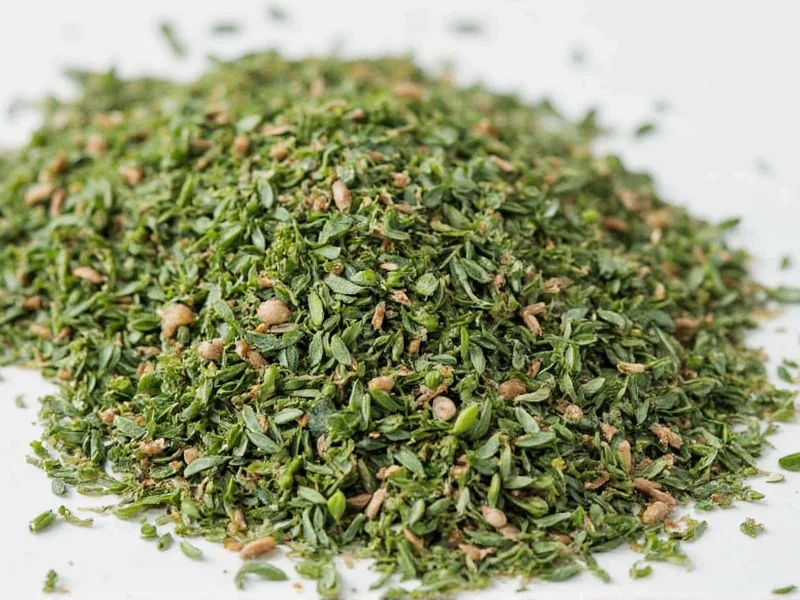The standard fresh to dried thyme ratio is 3:1. This means 3 parts fresh thyme equals 1 part dried thyme. For precise measurements: 1 teaspoon fresh thyme equals 1/3 teaspoon dried thyme, and 1 tablespoon fresh thyme equals 1 teaspoon dried thyme. This conversion accounts for dried thyme's concentrated flavor due to moisture removal during the drying process.
Understanding herb conversions is essential for consistent cooking results. When substituting fresh thyme for dried (or vice versa), getting the ratio right prevents your dishes from becoming either bland or overpowering. The 3:1 fresh to dried thyme ratio isn't arbitrary—it reflects the significant concentration of essential oils that occurs when moisture is removed from fresh herbs.
Why the 3:1 Fresh to Dried Thyme Ratio Works
Thyme loses approximately 70-80% of its weight during the drying process as water evaporates. This concentration means dried thyme packs more flavor compounds per volume than its fresh counterpart. The essential oils responsible for thyme's distinctive aroma and taste become more potent in dried form.
Fresh thyme contains moisture that dilutes its flavor profile, while dried thyme offers intensified flavor in a smaller package. This explains why using equal amounts would result in dried thyme overwhelming your dish. Professional chefs and experienced home cooks rely on this precise fresh thyme to dried thyme conversion to maintain recipe integrity regardless of which form they have available.
Practical Fresh and Dried Thyme Conversion Chart
| Fresh Thyme | Dried Thyme Equivalent | Best For |
|---|---|---|
| ¼ teaspoon | ⅛ teaspoon | Delicate sauces, finishing dishes|
| ½ teaspoon | ⅙ teaspoon | Light soups, egg dishes|
| 1 teaspoon | ⅓ teaspoon | Standard recipe measurements|
| 1 tablespoon | 1 teaspoon | Stews, roasts, braises|
| ¼ cup | 1¼ tablespoons | Large batch cooking, preserving|
| ½ cup | 2½ tablespoons | Commercial cooking, canning
Adjusting the Standard Fresh to Dried Thyme Ratio
While the 3:1 ratio serves as an excellent starting point, several factors may require slight adjustments to your fresh thyme measurement to dried conversion:
- Age of dried thyme: Dried herbs lose potency over time. Thyme older than 6 months may need a 2.5:1 ratio instead of 3:1
- Drying method: Sun-dried thyme often has more concentrated flavor than oven-dried
- Recipe cooking time: For long-simmered dishes, reduce dried thyme by 10-15% as flavors intensify over time
- Personal taste preferences: Some palates detect thyme's bitterness more strongly in dried form
When converting recipes calling for "a sprig of thyme," remember that one average sprig yields about 1/4 teaspoon fresh leaves. This translates to roughly 1/12 teaspoon dried thyme—easily rounded to 1/8 teaspoon for practical measuring.
Fresh vs Dried Thyme: Flavor Profile Differences
Understanding the flavor differences between fresh and dried thyme helps refine your fresh to dried thyme conversion:
- Fresh thyme: Offers brighter, more floral notes with subtle lemon undertones and a delicate aroma
- Dried thyme: Develops deeper, earthier characteristics with more pronounced pine-like notes
These flavor variations mean that while the 3:1 ratio works for volume conversion, the taste experience won't be identical. For dishes where thyme plays a starring role (like herbes de Provence or bouquet garni), consider using 10-15% less dried thyme than the standard conversion suggests to better match fresh thyme's subtlety.
Proper Storage for Maximum Flavor Retention
How you store both forms significantly impacts their potency and thus your fresh thyme to dried thyme conversion accuracy:
- Fresh thyme: Store upright in a glass with 1 inch of water, covered loosely with a plastic bag in the refrigerator. Properly stored, it maintains peak flavor for 10-14 days.
- Dried thyme: Keep in an airtight container away from light and heat. Proper storage preserves 80% of its potency for 6-12 months (compared to 1-3 months in poor conditions).
Test your dried thyme's potency by rubbing a small amount between your fingers. If you don't detect a strong aroma, it's lost significant flavor and you'll need to increase the amount beyond standard dried thyme equivalent measurements.
Common Fresh to Dried Thyme Conversion Mistakes
Avoid these frequent errors when working with thyme conversions:
- Using equal amounts: This results in dried thyme overpowering your dish
- Not accounting for leaf density: Packed fresh thyme contains more leaves per volume than loosely packed
- Ignoring recipe timing: Adding dried thyme too late in cooking prevents full flavor development
- Measuring whole sprigs as leaves: Recipes specifying "thyme leaves" require stripping from stems first
For the most accurate fresh thyme measurement to dried conversion, always measure leaves after removing them from stems—never measure whole sprigs unless specifically instructed.
When to Choose Fresh Over Dried Thyme
While the fresh to dried thyme ratio allows substitution, certain applications benefit from using one form over the other:
- Use fresh thyme when: Making delicate sauces, finishing dishes, preparing raw applications like salad dressings, or when visual appeal matters
- Use dried thyme when: Creating long-simmered dishes, making dry rubs, preparing spice blends, or when fresh isn't available
Understanding these applications helps you decide whether to adjust the standard fresh to dried thyme ratio based on your specific culinary needs rather than just substituting mechanically.











 浙公网安备
33010002000092号
浙公网安备
33010002000092号 浙B2-20120091-4
浙B2-20120091-4